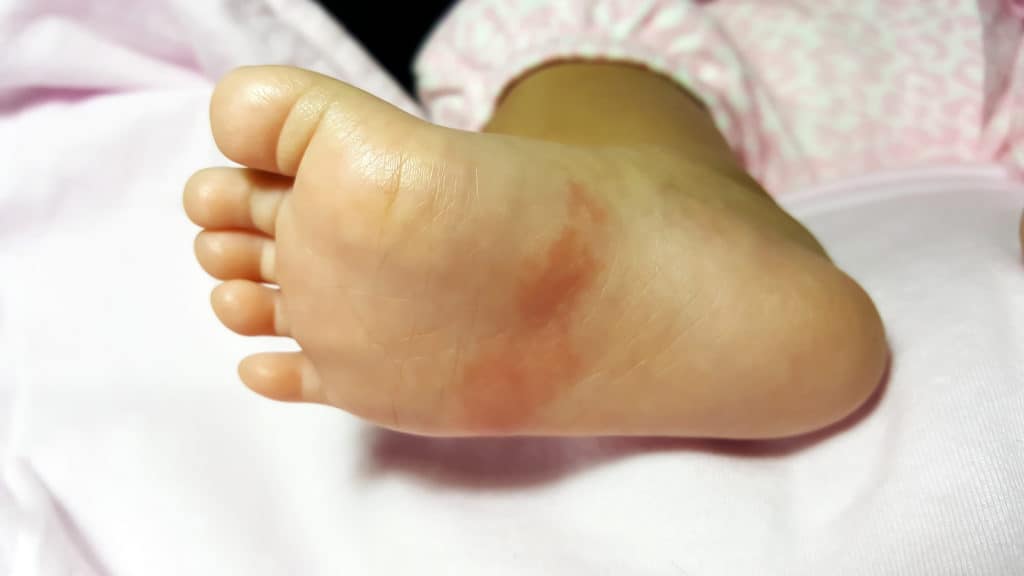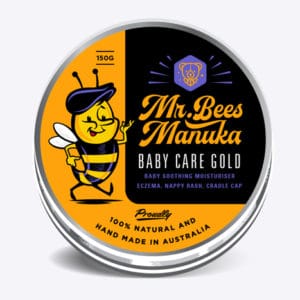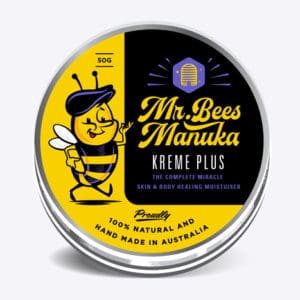Baby psoriasis is fairly common and like adults psoriasis can appear on different parts of the body.
Here Is What Baby Psoriasis Looks Like:
Baby psoriasis consists of patches which are the build up of excess skin sells, that look red or white and very scaly.
Psoriasis on a baby can be found anywhere on the body, and sometimes it can be confused with cradle cap or nappy rash, so it is good to know the difference between the three.
In this article we are going to discuss what baby psoriasis looks like, what age can a child or baby develop psoriasis, and how to treat baby psoriasis.
-
Baby Care Gold 150gm$37.00
-
Kreme Plus 50gm$22.00
What Does Baby Psoriasis Look Like?
Psoriasis is a skin condition that causes the cells in your skin to multiply much faster than normal, sometimes up to 10 times faster.
This leads to bumpy, scaly patches appearing on parts of the body, and they are often red and flaky too due to irritation.
These patches are actually the build-up of excess skin cells during the regeneration process, which takes between 3 and 7 days for somebody suffering from psoriasis when it should typically take between 3 and 4 weeks.
This skin condition is most commonly seen in adults over the age of 35, but it can also affect babies.
Baby psoriasis looks much the same as adult psoriasis: scaly patches of red or white skin, most commonly found on the elbows, knees, and lower back.
Lots of babies suffer from scaly and flaking skin on the scalp; if this isn’t a case of cradle cap then it is psoriasis.
Luckily, baby psoriasis often leads to smaller and softer patches of irritated skin, which means that these cases are far less likely to be extreme.
If you notice what looks like a rash or a lesion on your baby’s skin, you should have it checked out because it might be psoriasis.
Once you’ve diagnosed what skin condition your baby is suffering from, you’ll be able to go about healing it and making your baby more comfortable.
Always feel for any raised bumps on your baby’s skin because they are indicators of psoriasis.
If you yourself suffer from the condition, you’ll know the signs to look for, though keep in mind that baby psoriasis will typically look a lot milder than an adult case.
This can make it harder to spot, but any changes to a baby’s skin are fairly easy to pick up on.

At What Age Can A Child Get Psoriasis?
Children are a lot less likely to suffer from psoriasis than adults are, but they can develop the condition at any age.
A lot of babies suffer from a flaky scalp at the very least, so a child can definitely get psoriasis at just a few months old.
It likely isn’t anything to worry about, but you should always check your baby for any signs of psoriasis or another skin condition because they won’t be able to tell you about it.
If they do not develop psoriasis as a baby, a young child in their toddler years could start experiencing the condition.
And if a child does not suffer from psoriasis, that doesn’t mean that they won’t develop symptoms in their teen years because there is no set age that a child is most likely to experience psoriasis.
Lots of children will not develop the skin condition at all, but those who do should be able to tell you that they have a rash or other patch of irritated skin.
Psoriasis can happen without anything at all prompting it, though it is thought that things like cuts and scrapes can trigger it because the skin cells need to reproduce quickly in response to their physical trauma.
Young children are more likely to get cuts and scrapes when they are playing or enjoying the outdoors, which could increase the likelihood of your child developing psoriasis while they are still quite young.
Keeping the skin clean and dry is also a good way to ward off psoriasis, which is why babies are at risk of developing the condition in the area of their diaper because it will get damp and clammy a lot.
-
Baby Care Gold 150gm$37.00
-
Kreme Plus 50gm$22.00
Can Babies Have Psoriasis?
Babies can definitely get psoriasis, but you’ll be changing and bathing your baby every single day so you’ll likely catch the symptoms as soon as they appear.
Sometimes, psoriasis can look like diaper rash, so it is best to get a suspected diaper rash checked just in case it turns out to be something else.
Psoriasis on a baby’s scalp looks a lot like cradle cap (white, flaking skin on the head), which is another reason to make sure it isn’t actually psoriasis.
Babies rarely develop psoriasis and if they do, it will never be as bad as an adult case.
It is more likely that the flaking skin on your baby’s head is cradle cap and that the redness on their lower back and bottom is a diaper rash, but it is always safest to check when you notice something abnormal on their skin.
Once of the biggest indicators of psoriasis is the skin appearing scaly and raised, so look out for that and always seek further advice about potential skin irritations.

How Do You Treat Psoriasis In Babies?
Like the majority of skin conditions, psoriasis is treated by the application of creams.
A mild case of psoriasis can be treated with a cream or lotion that will calm down the redness and dryness, as well as promote healing in the skin.
One cream that is a particularly good choice for this is a cream that contains Manuka honey because that will cleanse and moisturize the skin, as well as clearing up the inflammation.
Other creams with good moisturizing properties are also excellent for treating psoriasis because you need the skin to soften up.
A case of psoriasis in babies shouldn’t take much cream to sort out, especially since the patches are often small and fairly soft to begin with. You might have to apply these creams fairly regularly because babies roll around and might rub off some of the ointment during the day.
Psoriasis can also be treated without any creams being used. You should try to keep your baby’s skin clean and dry at all times and avoid letting them get too hot or cold because that can make the irritated skin worse.
A very bad case of baby psoriasis, though rare, might need to be treated with oral antibiotics, though a doctor will need to judge if that will be necessary.
Never use a cream or lotion with harsh ingredients in it to treat psoriasis in babies because their skin is so soft and delicate. That is why something like a Manuka honey cream is the best option because it is completely natural and kind to skin.
You don’t want to risk irritating your baby’s skin further if they are already suffering from psoriasis, especially because they won’t be able to verbally tell you that they are experiencing discomfort.
The best way that you can treat psoriasis in babies is to keep a constant eye on their skin and have a medical professional take a look at any new skin development to make sure it isn’t psoriasis or another condition.
All babies go through excessive, flaky skin, especially on the scalp, so even though it is most likely that it will turn out to be nothing, keeping an eye on their skin is the easiest way to be sure. Then, if you do notice any skin becoming irritated, you can get the relevant creams to treat the problem.
Please Note: (Always good to do a patch test on the skin first to see if there is no reaction to any product. If there is, discontinue use and go and see your doctor).
-
Baby Care Gold 150gm$37.00
-
Kreme Plus 50gm$22.00
If I Have Psoriasis, Will My Baby Get It?
Like a lot of conditions, having psoriasis yourself can make you more likely to pass it onto your own children. If just one parent suffers from the condition, the baby’s chance of developing it is 15%, but if both parents have psoriasis, the likelihood increases to 75%.
So, if you or your partner have suffered from skin psoriasis, you might want to be more alert when it comes to checking your children for symptoms.
However, there is never a 100% chance of your baby developing psoriasis if you have suffered from it, especially since cases of baby psoriasis are so rare. It is a condition that is likely to become hereditary, but that is not guaranteed to happen.
And if your baby does show signs of having psoriasis, you’ll have experience with how to treat it due to dealing with your own symptoms over the years.

Can Babies Grow Out Of Psoriasis?
Psoriasis is not a condition that can be cured, but the symptoms can be managed and sometimes completely eradicated until the next time that your skin flares up.
So, babies cannot grow out of psoriasis, but their symptoms can be easily managed to ensure that they are never uncomfortable due to their skin being bumpy or dry.
The majority of cases of baby psoriasis are mild anyway, so as long as you notice the symptoms, you shouldn’t have any trouble with managing the condition.
If baby psoriasis is considered severe, more treatment might be needed, but it can still be managed fairly easily with the help of a doctor.
Finding a good cream or ointment that works to get rid of the symptoms whenever they appear will make life so much easier because you’ll be able to apply it to your baby’s skin regularly and know that it will work.
Psoriasis is not a life-threatening condition, but recognising and treating it is the best way for you to help your baby learn about their skin and caring for it as they grow up.



